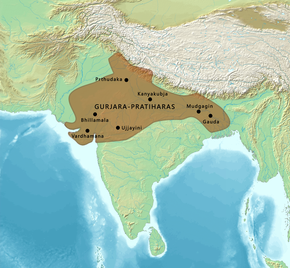
Back سلالة غورجارا براتيهارا Arabic Gurjara-Pratihara Catalan Pratihara German Gurjara-Pratihara Spanish سلسله گورجارا-پراتیهارا Persian Gurjara-Pratihara Finnish Pratihâra French गुर्जर-प्रतिहार राजवंश Hindi Dinasti Gurjara-Pratihara ID Gurjara-Pratihara Italian
Gurjara Pratihara dynasty | |
|---|---|
| c. 730 CE–1036 CE | |
Gurjara-Pratihara coinage of Mihira Bhoja, King of Kanauj. Obv: Boar, incarnation of Vishnu, and solar symbol. Rev: Traces of Sasanian type. Legend: Srímad Ādi Varāha "The fortunate primaeval boar".[1][2][3]
| |
Extent of the Pratihara Empire at its peak (c. 800—950 CE) and neighbouring polities.[4] | |
| Capital | |
| Common languages | Sanskrit, Prakrit |
| Religion | Hinduism |
| Government | Monarchy |
• c. 730–c. 760 | Nagabhata I (first) |
• c. 1024–c. 1036 | Yasahpala (last) |
| Historical era | Late Classical India |
• Established | c. 730 CE |
| 1008 CE | |
• Disestablished | 1036 CE |
| Today part of | |
The Gurjara-Pratihara was a dynasty that ruled much of Northern India from the mid-8th to the 11th century. They ruled first at Ujjain and later at Kannauj.
The Gurjara-Pratiharas were instrumental in containing Arab armies moving east of the Indus River.[5] Nagabhata I defeated the Arab army under Junaid and Tamin in the Caliphate campaigns in India. Under Nagabhata II, the Gurjara-Pratiharas became the most powerful dynasty in northern India. He was succeeded by his son Ramabhadra, who ruled briefly before being succeeded by his son, Mihira Bhoja. Under Bhoja and his successor Mahendrapala I, the Gurjara-Pratihara dynasty reached its peak of prosperity and power. By the time of Mahendrapala, the extent of its territory rivalled that of the Gupta Empire stretching from the border of Sindh in the west to Bengal in the east and from the Himalayas in the north to areas past the Narmada in the south.[6][7] The expansion triggered a tripartite power struggle with the Rashtrakuta and Pala empires for control of the Indian subcontinent. During this period, Imperial Pratihara took the title of Maharajadhiraja of Āryāvarta (Great King of Kings of Aryan Lands).
Gurjara-Pratihara are known for their sculptures, carved panels and open pavilion style temples. The greatest development of their style of temple building was at Khajuraho, now a UNESCO World Heritage Site.[8]
The power of the Gurjara-Pratihara dynasty was weakened by dynastic strife. It was further diminished as a result of a great raid led by the Rashtrakuta ruler Indra III who, in about 916, sacked Kannauj. Under a succession of rather obscure rulers, the dynasty never regained its former influence. Their feudatories became more and more powerful, one by one throwing off their allegiance until, by the end of the tenth century, the dynasty controlled little more than the Gangetic Doab. Their last important king, Rajyapala, was driven from Kannauj by Mahmud of Ghazni in 1018.[7]
- ^ Smith, Vincent Arthur; Edwardes, S. M. (Stephen Meredyth) (1924). The early history of India : from 600 B.C. to the Muhammadan conquest, including the invasion of Alexander the Great. Oxford : Clarendon Press. p. Plate 2.
- ^ Ray, Himanshu Prabha (2019). Negotiating Cultural Identity: Landscapes in Early Medieval South Asian History. Taylor & Francis. p. 164. ISBN 9781000227932.
- ^ Flood, Finbarr B. (20 March 2018). Objects of Translation: Material Culture and Medieval "Hindu-Muslim" Encounter. Princeton University Press. p. 40. ISBN 978-0-691-18074-8.
- ^ Schwartzberg, Joseph E. (1978). A Historical atlas of South Asia. Chicago: University of Chicago Press. p. 146, map XIV.2 (i). ISBN 0226742210.
- ^ Wink, André (2002). Al-Hind: Early Medieval India and the Expansion of Islam, 7th–11th Centuries. Leiden: BRILL. p. 284. ISBN 978-0-391-04173-8.
- ^ Avari 2007, p. 303.
- ^ a b Sircar 1971, p. 146.
- ^ Partha Mitter, Indian art, Oxford University Press, 2001 pp.66
© MMXXIII Rich X Search. We shall prevail. All rights reserved. Rich X Search
![Gurjara-Pratihara coinage of Mihira Bhoja, King of Kanauj. Obv: Boar, incarnation of Vishnu, and solar symbol. Rev: Traces of Sasanian type. Legend: Srímad Ādi Varāha "The fortunate primaeval boar".[1][2][3] of Gurjara Pratihara](http://upload.wikimedia.org/wikipedia/commons/thumb/7/7d/Pratihara_bhoja.JPG/250px-Pratihara_bhoja.JPG)

